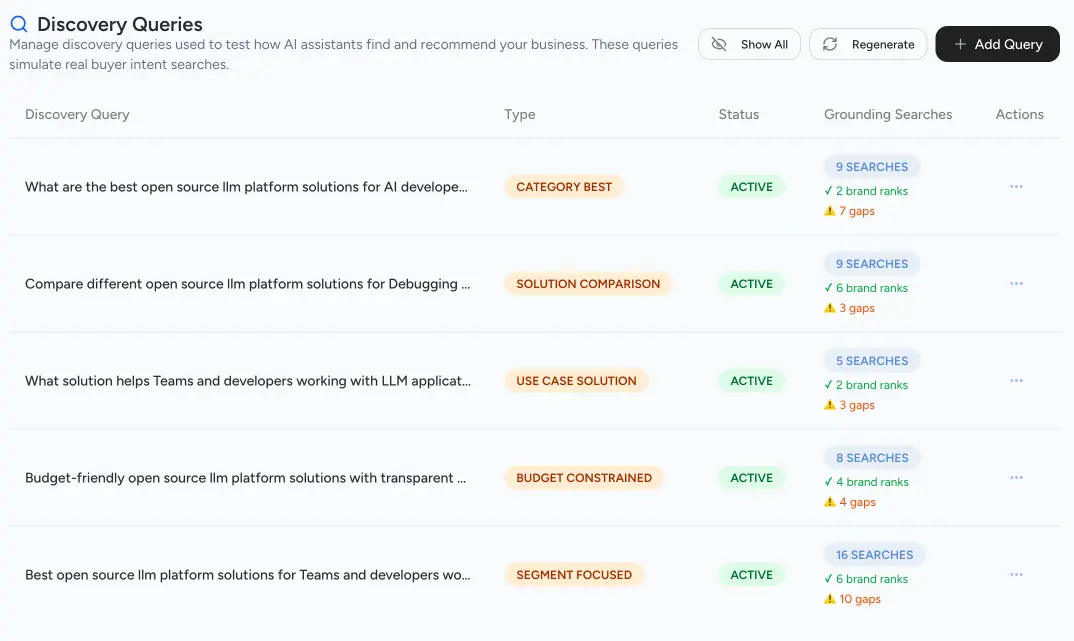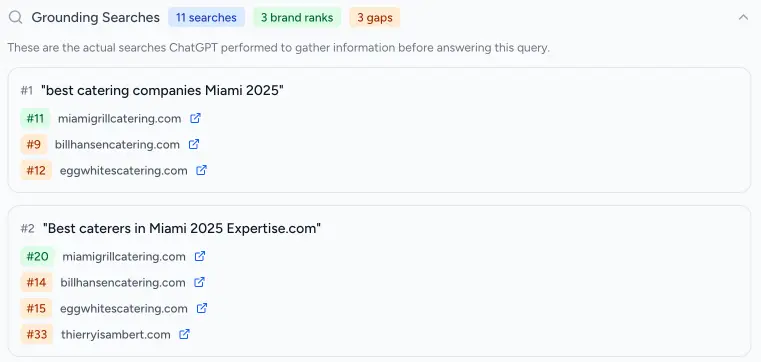Managing Discovery Queries
Discovery queries are the questions your prospects ask AI assistants when searching for solutions like yours. Managing these queries helps you understand and improve how AI platforms recommend your brand.
What You'll Learn
In this guide, you'll learn:
- What discovery queries are and why they matter
- How to create effective custom queries
- How to view grounding searches and rankings
- How to use query data to improve your content
Understanding Discovery Queries
A discovery query is a question someone might ask an AI assistant when looking for a solution you provide. For example:
- "What project management software helps with team collaboration?"
- "Best restaurants for birthday dinners in Austin, Texas"
- "Affordable CRM under $50 per month"
When you run an AI Visibility Report, Spyglasses tests these queries across multiple AI platforms to see if your brand gets mentioned and how you compare to competitors.
Automatic Query Generation
Spyglasses automatically generates discovery queries based on your brand snapshot. These cover common search patterns:
- Best in Category: "What are the best [category] for [use case]?"
- Use Case Exploration: "What [product] helps with [specific need]?"
- Budget Constrained: "Affordable [product] under [price point]"
- Comparison: "Compare different [category] for [use case]"
- Segment Specific: "Best [product] for [target customer]"
- Local Services: "[Business type] near [location]"
These queries ensure your reports test the most common ways prospects search for solutions like yours.
Creating Custom Queries
Navigate to your property's Discovery Queries section from the sidebar under Configuration.

To create a custom query:
- Click "Add Discovery Query"
- Enter your query text exactly as a user might ask it
- Select the query type (Best in Category, Use Case, etc.)
- Choose the location if relevant for local businesses
- Click "Save"
Writing Effective Queries
Good discovery queries are:
Specific enough to be realistic
- ✅ "What CRM integrates with Salesforce and costs under $100/month?"
- ❌ "CRM software"
Natural language, not keywords
- ✅ "Best project management tools for remote teams"
- ❌ "project management software best remote"
Representative of your prospects
- ✅ "Marketing automation for B2B SaaS companies under 50 employees"
- ❌ "Enterprise marketing platform with advanced segmentation"
Focused on outcomes, not features
- ✅ "Software to reduce customer support response times"
- ❌ "Ticketing system with automated routing"
Query Types Explained
Best in Category: Broad searches where users want to see top options. High competition but also high intent.
Use Case Exploration: Problem-first searches. Users know their challenge but not the solution. Great for positioning against alternatives.
Budget Constrained: Price-sensitive searches. Important if you compete on value.
Comparison: Direct competitive searches. Critical for understanding head-to-head positioning.
Segment Specific: Niche searches targeting specific industries or customer types. Often lower volume but higher conversion.
Local Services: Location-based searches for physical businesses. Essential for restaurants, retail, and local services.
Viewing Query Performance
Click on any discovery query row in the table to open its detail page. This page provides in-depth analysis of how AI platforms handle this specific query.

Performance Metrics
The detail page shows:
- Total mentions: How many times your brand appeared across all platforms for this query
- Share of Voice: Your percentage of visibility compared to all brands mentioned
- Competitor presence: Which competitors appeared and how often
- Citation data: How many times AI cited your domain as a source
Grounding Searches
When AI platforms answer your discovery query, they often perform additional searches to gather information. These "grounding searches" reveal what AI considers relevant for answering the query.

For each grounding search, you'll see:
- The exact search query AI performed
- Your brand's ranking (1-30) if you appeared
- Competitor rankings
- Link to the page that ranked
Why Grounding Searches Matter
Grounding searches show you exactly where you need to rank to improve AI visibility. If AI performs a search like "best project management tools 2024" and your brand doesn't appear in the top 30 results, you won't be mentioned in the AI response—even if you're a perfect fit for the user's query.
This is different from traditional SEO because you're optimizing for what AI searches for, not what humans search for. These searches tend to be:
- More specific and detailed
- Focused on comparison and evaluation
- Heavy on "best," "top," and "recommended" modifiers
Gap Opportunities
The detail page highlights queries where competitors rank in grounding searches but you don't. These represent your clearest path to improving visibility:
- Identify the gap: Note which grounding search you're missing from
- Check competitor content: See what pages rank for your competitors
- Create or optimize: Build content specifically targeting that search
- Verify ranking: Use traditional search to confirm you rank in top 30
- Re-test: Run a new AI Visibility Report to see if you now appear
Managing Your Query Library
Editing Queries
Click the edit icon to modify:
- Query text (useful if testing variations)
- Query type (affects how reports categorize results)
- Location (for local businesses testing different markets)
Archiving Queries
Delete queries that are:
- No longer relevant to your positioning
- Too broad or too narrow to be useful
- Duplicating other queries in your list
Your query library persists across reports, so keep it focused on your highest-priority searches.
Organizing by Priority
While Spyglasses doesn't have explicit priority levels, you can organize queries by:
- Core positioning: Queries central to how you want AI to recommend you
- Competitive: Queries where competitors dominate
- Emerging: New market opportunities or product launches
- Testing: Experimental queries to understand AI behavior
Focus report analysis on core and competitive queries, while using emerging and testing queries for long-term planning.
Best Practices
Start with 5-10 Core Queries
Don't create 50 queries right away. Start with the 5-10 most important ways prospects find solutions like yours. Add more as you learn what works.
Test Variations
Create slight variations to understand what language triggers AI recommendations:
- "Best CRM for small business" vs "Top CRM platforms for startups"
- "Project management software" vs "Tools to manage projects"
Include Competitor Comparisons
Add queries that explicitly compare you to competitors:
- "Compare [Your Brand] vs [Competitor]"
- "Alternatives to [Competitor]"
This ensures you test direct competitive positioning.
Review After Each Report
After running an AI Visibility Report, review which queries performed well and which revealed gaps. Adjust your query library based on findings.
Align with Actual Customer Language
Review:
- Sales call transcripts
- Support tickets
- Search console queries
Create discovery queries that match how real customers describe their needs.
How This Ties to AI Search Visibility
Discovery queries are the foundation of your AI visibility strategy because:
-
They define what you're optimizing for: You can't improve what you don't measure. Your query library determines what AI behaviors you track.
-
They reveal search patterns: Grounding searches show you exactly what terms AI platforms use to evaluate your space, guiding your content strategy.
-
They provide competitive intel: Seeing which competitors appear for which queries reveals positioning opportunities you might have missed.
-
They validate optimization efforts: After creating new content, re-test relevant queries to confirm AI now recommends you.
-
They prioritize your roadmap: Queries with high competitor SOV but low brand presence should drive your content calendar.
The queries you track directly determine how useful your AI Visibility Reports are. Invest time in building a library that represents real prospect searches, and you'll have a roadmap for becoming the AI's top recommendation in your space.